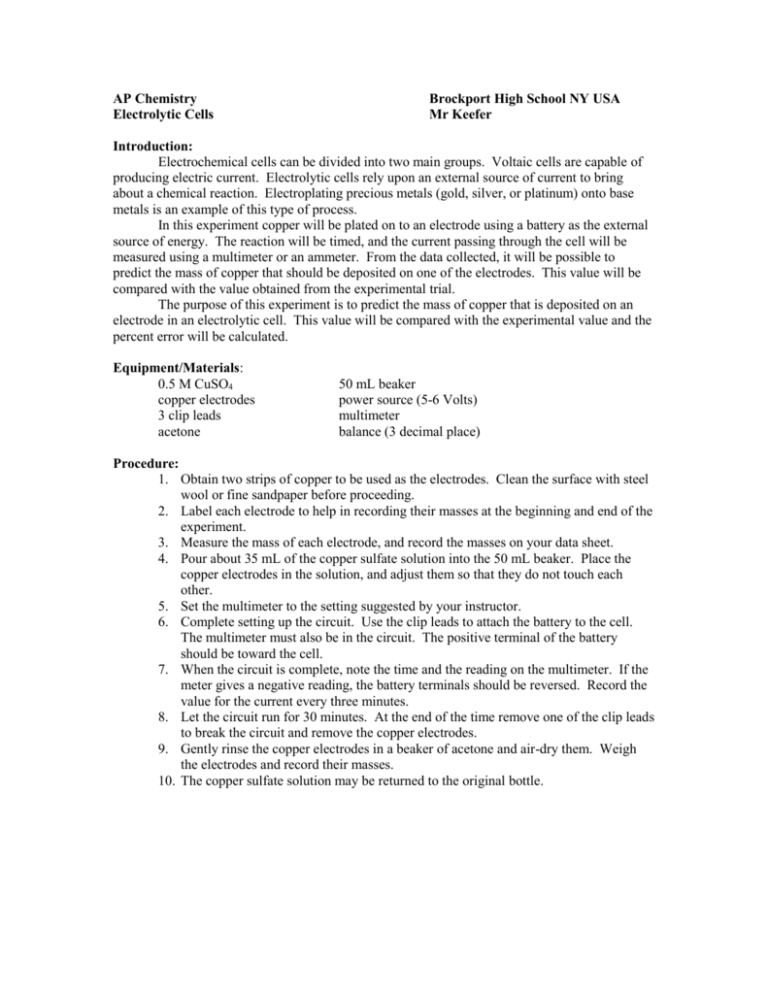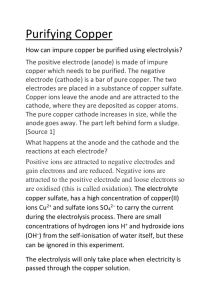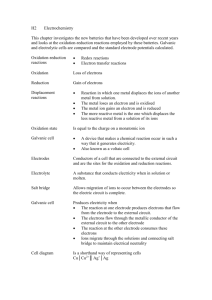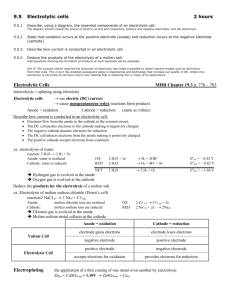Electrolytic Cells
advertisement

AP Chemistry Electrolytic Cells Brockport High School NY USA Mr Keefer Introduction: Electrochemical cells can be divided into two main groups. Voltaic cells are capable of producing electric current. Electrolytic cells rely upon an external source of current to bring about a chemical reaction. Electroplating precious metals (gold, silver, or platinum) onto base metals is an example of this type of process. In this experiment copper will be plated on to an electrode using a battery as the external source of energy. The reaction will be timed, and the current passing through the cell will be measured using a multimeter or an ammeter. From the data collected, it will be possible to predict the mass of copper that should be deposited on one of the electrodes. This value will be compared with the value obtained from the experimental trial. The purpose of this experiment is to predict the mass of copper that is deposited on an electrode in an electrolytic cell. This value will be compared with the experimental value and the percent error will be calculated. Equipment/Materials: 0.5 M CuSO4 copper electrodes 3 clip leads acetone 50 mL beaker power source (5-6 Volts) multimeter balance (3 decimal place) Procedure: 1. Obtain two strips of copper to be used as the electrodes. Clean the surface with steel wool or fine sandpaper before proceeding. 2. Label each electrode to help in recording their masses at the beginning and end of the experiment. 3. Measure the mass of each electrode, and record the masses on your data sheet. 4. Pour about 35 mL of the copper sulfate solution into the 50 mL beaker. Place the copper electrodes in the solution, and adjust them so that they do not touch each other. 5. Set the multimeter to the setting suggested by your instructor. 6. Complete setting up the circuit. Use the clip leads to attach the battery to the cell. The multimeter must also be in the circuit. The positive terminal of the battery should be toward the cell. 7. When the circuit is complete, note the time and the reading on the multimeter. If the meter gives a negative reading, the battery terminals should be reversed. Record the value for the current every three minutes. 8. Let the circuit run for 30 minutes. At the end of the time remove one of the clip leads to break the circuit and remove the copper electrodes. 9. Gently rinse the copper electrodes in a beaker of acetone and air-dry them. Weigh the electrodes and record their masses. 10. The copper sulfate solution may be returned to the original bottle. ELECTROLYTIC CELLS Data: 1. Mass of electrodes before: Anode _______________ Cathode _______________ 2. Mass of electrodes after: Anode _______________ Cathode _______________ 3. Mass Change: Anode _______________ Cathode _______________ 4. Current Time Current Time Average Current = __________ amps 5. Length of time: __________ minutes = __________ seconds Calculations: 1. Draw a diagram of your electrolytic cell and label the components. Current 2. Using the time and the average current above, calculate the mass of metal that should have deposited. 3. Calculate the percent error for the trial. Questions: 1. What is the difference between a voltaic and an electrolytic cell? 2. How could you determine which electrode is the cathode if the electrodes were not labeled? 3. Do both electrodes need to be made of the same metal? Is there an advantage if the anode is the same metal as the metal in the plating solution? 4. What are some possible sources of error in this experiment? ELECTROLYTIC CELLS TEACHER NOTES Lab Time: 80 minutes. This allows enough time to discuss, set up, run, and discuss the calculations. Preparation: Time: 30 minutes. T: Prepare the 0.5 M CuSO45H2O solution by dissolving 125 g of CuSO4 in enough water to make 1 L of solution. This solution can be recycled. Answers to Questions: 1. What is the difference between a voltaic and an electrolytic cell? A voltaic cell produces energy. An electrolytic cell requires an external source of energy. 2. How could you determine which electrode is the cathode if the electrodes were not labeled? The cathode is the electrode that will increase in mass. 3. Do both electrodes need to be made of the same metal? Is there an advantage if the anode is the same metal as the metal in the plating solution? No, the concentration of metal in the solution will remain constant if the anode is made of the same metal. 4. What are some possible sources of error in this experiment? Weighing electrodes that are not dry, losing copper plated on the cathode, not timing the experiment properly, and not monitoring the current will all result in errors.







